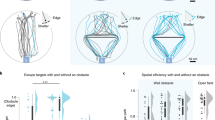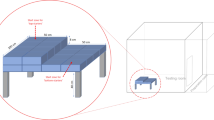Abstract
In order to uncover processes in the acquisition of spatial representation, we tested voles, jirds, and mice in a dark grid maze—a relatively homogenous environment comprising 16 identical equispaced crossroads and similar choice of paths at each crossroad. The three species initially displayed a tendency to retrace sections of their recently traversed path, perhaps indicating exploration and learning of an unfamiliar environment by virtue of repetition. All three species displayed the same decision making at crossroads. They had an equal tendency to progress forward, turn sideways, or turn back to retrace their path upon the first arrival at each crossroad. Over repeated visits to the same crossroad, however, progressing forward increased along with a decrease in turning back, but there was no change in the incidence of turning sideways. It is suggested that progressing forward is easier than making turns, since the latter oblige the navigator to remember the location of turning in order to retrace or integrate the path and remain oriented. The incidence of turning sideways, in being more difficult than forward progression and retracing, yet necessary in a restricted maze space, did not change over repeated visits to crossroads. Altogether, decision making at a crossroad may be described as going straight ahead for simplicity, retracing a path to memorize it, or turning sideways at a constant rate. The present tests in the grid maze illustrate how tangible entities (crossroads, paths) are integrated during the early phase of acquiring an abstract representation (map) of the maze.





Similar content being viewed by others
References
Alyan SH, Jander R (1994) Short-range homing in the house mouse, Mus musculus: stages in the learning of directions. Anim Behav 48:285–298
Avni R, Eilam D (2008) On the border: ‘perimeter patrolling’ as a proposed transitional exploration phase from piloting to orienting in a diurnal rodent, the fat sand rat (Psammomy obesus). Anim Cogn 11:311–318
Avni R, Zadicario E, Eilam D (2006) Exploration in a dark open field: a shift from directional to positional progression and a proposed model of acquiring spatial information. Behav Brain Res 171:313–323
Avni R, Tzvaigrach Y, Eilam D (2008) Exploration and navigation in the blind mole rat (Spalax ehrenbergi): global calibration as a primer of spatial representation. J Exp Biol 211:2817–2826
Bartumeus F, Peters F, Pueyo S, Marras C, Catalan J (2003) Helical Levy walks: adjusting searching statistics to resource availability in microzooplankton. PNAS USA 100:12771–12775
Bengtsson G, Nilsson E, Ryden T, Wiktorsson M (2004) Irregular walks and loops combines in small-scale movement of a soil insect: implications for dispersal biology. J Theor Biol 231:299–306
Benhamou S, Poucet B (1998) Landmark use by navigating rats (Rattus norvegicus): contrasting geometric and featural information. J Comp Psychol 112:317–322
Cheng K (1986) A purely geometric module in the rat’s spatial representation. Cognition 23:149–178
Cheng K (2005) Reflections on geometry and navigation. Connect Sci 17:5–21
Cheng K, Newcombe NS (2005) Is there a geometric module for spatial orientation? Squaring theory and evidence. Psychon Bull Rev 12:1–23
Cheng K, Gallistel CR (2005) Shape parameters explain data from spatial transformations: comment on Pearce et al. (2004) and Tommasi & Polli (2004). J Exp Psychol Anim Behav Process 31:254–259
Clark BJ, Hamilton DA, Whishaw IQ (2006) Motor activity (exploration) and formation of home bases in mice (C57BL/6) influenced by visual and tactile cues: modification of movement geometry, distance, location and speed. Physiol Behav 87:805–816
Collett TS (1996) Insect navigation En route to the goal: multiple strategies for the use of landmarks. J Exp Biol 199:227–235
Dashiell JF (1930) Direction orientation in maze running by the white rat. Comp Psychol Monogr 7:32
Ebbinghaus H (1885) Memory: a contribution to experimental psychology (trans: HA Ruger, CE Bussenues, 1913). Teachers College, Columbia University, New York
Eilam D (1997) Postnatal development of body architecture and gait in the postnatal development of several rodent species. J Exp Biol 200:1339–1350
Eilam D, Golani I (1989) Home base behavior of Rats (Rattus norvegicus) exploring a novel environment. Behav Brain Res 34:199–211
Etienne AS, Boulens V, Maurer R, Rowe T, Siegrist C (2000) A brief view of known landmarks reorientates path integration in hamsters. Naturwissenschaften 87:494–498
Gallistel CR (1990) The organization of learning. MIT Press, Cambridge
Golledge RG (1999) Human cognitive maps and wayfinding. In: Golledge RG (ed) Wayfinding behavior: cognitive mapping and other spatial processes. Johns Hopkins University Press, Baltimore, pp 5–45
Gouteux S, Thinus-Blanc C, Vauclair J (2001) Rhesus monkeys use geometric and nongeometric information during a reorientation task. J Exp Psychol Gen 130:505–519
Guazzelli A, Bota MA, Arbib MA (1998) Affordances, motivation, and the world graph theory. Adapt Behav 6:435–471
Hill K (1998) The psychology of lost. In: Hill K (ed) Lost person behavior. National SAR Secretariat, Ottawa, pp 1–16
Hills TT (2006) Animal foraging and the evolution of goal-directed cognition. Cogn Sci 30:3–41
Lorenz K (1952) King Solomon’s ring: new light on animals ways. Meridian Books (Penguin), New York
Mendelssohn H, Yom-Tov Y (1999) Fauna palaestina: mammalia of Israel. Keterpress Enterprises, Jerusalem
Narendra A, Cheng K, Sulikowski D, Wehner R (2008) Search strategies of ants in landmark-rich habitats. J Comp Physiol A 194:929–938
O’Keefe J, Nadel L (1978) The hippocampus as a cognitive map. Oxford University Press, Oxford
Souman J, Frissen I, Sreenivasa M, Ernst M (2009) Walking straight into circles. Curr Biol 29:1538–1542
Tchernichovski O, Benjamini Y, Golani I (1998) The dynamics of long term exploration in the rat—part I. A phase plane analysis of the relationship between location and velocity. Biol Cybern 78:423–432
Tolman EC (1932) Purposive behavior in animal and man. University of California Press, Berkley
Whishaw IQ, Hines DJ, Wallace DG (2001) Dead reckoning (path integration) requires the hippocampal formation: evidence from spontaneous exploration and spatial learning tasks in light (allothetic) and dark (idiothetic) tests. Behav Brain Res 127:49–69
Xia J, Arrowsmith C, Jackson M, Cartwright W (2008) The wayfinding process relationships between decision-making and landmark utility. Tour Manag 29:445–457
Yaski O, Portugali J, Eilam D (2009) The dynamic process of cognitive mapping in the absence of visual cues: human data compared to animal studies. J Exp Biol 212:2619–2626
Zadicario P, Avni R, Zadicario E, Eilam D (2005) ‘Looping’—an exploration mechanism in a dark open filed. Behav Brain Res 159:27–36
Acknowledgments
We are grateful to Dr. Reut Avni for her help in testing the jirds, to Pazit Zadicario for data analysis, to Naomi Paz for language editing, and to Barak Levy for help in maintaining the rodent colonies. This study was supported by The Israel Science Foundation, Grant 177/09.
Author information
Authors and Affiliations
Corresponding author
Rights and permissions
About this article
Cite this article
Miller, M., Eilam, D. Decision making at a crossroad: why to go straight ahead, retrace a path, or turn sideways?. Anim Cogn 14, 11–20 (2011). https://doi.org/10.1007/s10071-010-0338-5
Received:
Revised:
Accepted:
Published:
Issue Date:
DOI: https://doi.org/10.1007/s10071-010-0338-5




